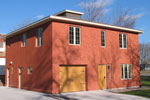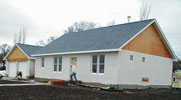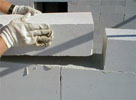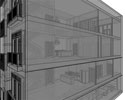Thermal Mass
Content under development. March 2008.
The advantages of thermal mass heat storage are best summed up with the bungalow we built in South Dakota. Zero to twenty dec jan feb The average outdoor temperature during January is minus ten degrees Farrenhight. We had been heating the 2500 square foot house to 65 degrees for several weeks. Then during a particular cold spell of we decided to completely turn off the heat. The indoor temperature fell on average 1.4 degrees per day. After a ten day period the temperature was still 40’s degrees. It is also worth noting that the house was not occupied during this period so there was no additional heat input from kitchen appliances, showers and people, and there were no curtains on the windows.
In contrast, non-thermal mass buildings can store very little heat in the building structure and contents. When the furnace or radiators turn on, they primarily heat the air. Any time a door is opened that heat can quickly flow out. Furthermore, it is very difficult to completely seal a wood house to prevent drafts and air infiltration. This allows heat to continually flow out of the house. With very little heat storage, the indoor air temperature rises and falls as the thermostat turns the furnace on and off. It is close to impossible to have a constant temperature, and usually different parts of the house are at different temperatures (cooler near windows and drafts). Any loss of heating, whether an electrical outage or furnace breakdown, will quickly result in a cold, uncomfortable house.
A house built with AAC walls and concrete floors, first is able to store large amounts of heat with its mass, and second is more airtight. One may wonder how ACC can “breath” and still be more airtight. The short answer is air cannot blow through AAC and the joints between blocks are completely sealed. The longer answer is that the cellular structure (eg all those tiny bubbles) of AAC allows air and water molecules to slowly diffuse (flow) from areas of greater concentration to areas of lower concentration. Diffusion is similar to, but not the same as evaporation. Evaporation is a change from a liquid to a gas. Diffusion is movement from higher to lower areas of concentration. Diffusion similar to how water will spread across a dry paper towel when you lay one corner in a pool of water. Another way to think of AAC is a Gore-Tex™ jacket. It can be raining and windy outside, but the jacket blocks the wind and rain from coming in and moisture inside the jacket is pushed out through the jacket due to temperature and relative humidity differences inside verses outside the jacket.
(During the winter air is drier and thus holds less heat Wood houses )
Off peak electric heat. Can stay heated in remote situations (off-grid and/or unrealiable) with small wood stove




